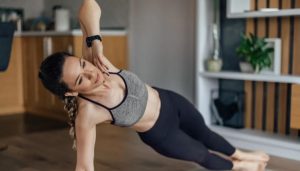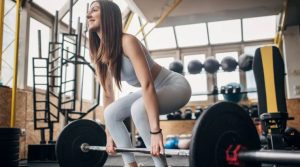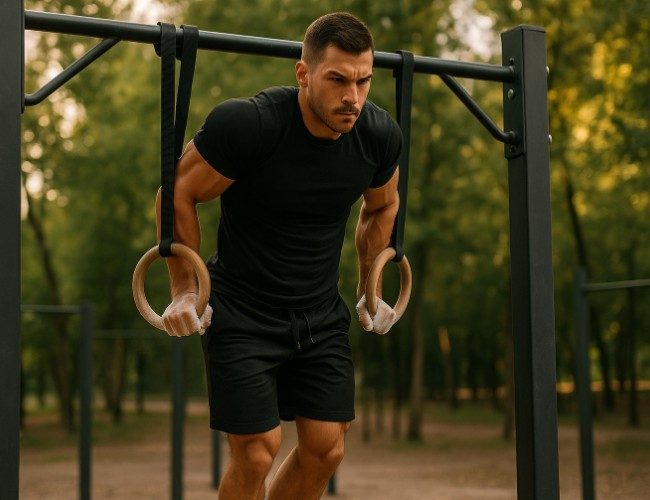
Calisthenics Benefits – What Are the Advantages of Calisthenics for Men and Women?
What Is Calisthenics and Why Is It Gaining Popularity?

What is Calisthenics in Simple Terms?
When I first encountered calisthenics, I assumed it was just a fancy term for push-ups. But I quickly learned it’s much more than that.
Calisthenics is a form of strength and movement training that uses only your bodyweight as resistance, no machines, no dumbbells, just your own mass against gravity.
It includes:
- Push-based movements (push-ups, dips)
- Pull-based movements (pull-ups, chin-ups)
- Leg work (squats, lunges, pistol squats)
- Core-focused exercises (planks, leg raises)
- Static holds (handstands, L-sits)
What makes calisthenics benefits stand out is how the exercises build strength, mobility, coordination, and control at the same time. You’re not just working one muscle, you’re training the whole system to move better and more powerfully.
Why Did I Choose Calisthenics Over Traditional Gym Training?
I started calisthenics out of necessity, no gym, no gear, and limited space. But it quickly became my long-term solution, not just a temporary fix.
Over time, I realised calisthenics wasn’t only more convenient, it aligned with my goals better than any gym workout ever had.
What drew me in:
- Zero equipment: All I needed was a mat, a bar, and my body.
- No time restrictions: I could train in my living room or at the park, day or night.
- Low pressure: No comparison, no mirrors, no waiting for machines.
- Holistic movement: I moved more like an athlete than a gym-goer.
Calisthenics became more than a training style. It became my gateway to sustainable, skill-based fitness.
Is It Equally Effective for Both Men and Women?
Yes, and that’s one of the most empowering aspects of calisthenics. It’s a training method that doesn’t discriminate based on gender. It adapts to your goals.
- Men may want upper-body strength, muscle growth, or explosive power.
- Women often aim for body toning, core development, or mobility improvement.
With calisthenics, both groups can train with similar movements, using progressions to scale difficulty based on ability and comfort, not gender stereotypes.
What Are the Physical Benefits of Calisthenics for Men and Women?

How Does Calisthenics Build Strength and Lean Muscle?
At first, I wasn’t convinced that bodyweight exercises could compete with heavy lifting. But I learned very quickly that calisthenics isn’t about how much you lift, it’s about how well you move.
Here’s how it builds real strength:
- Engages multiple muscle groups at once
- Requires core activation in nearly every movement
- Increases neuromuscular control, meaning better mind-muscle connection
- Promotes movement quality over pure weight lifted
I built muscle using progressive techniques:
- Moving from knee push-ups to archer push-ups
- Starting with negative pull-ups before hitting full reps
- Adding time under tension to increase difficulty
And it wasn’t just me, both male and female friends saw muscle gains without bulking or needing gym access.
Is It Possible to Tone Your Body Using Only Bodyweight?
Yes, 100%. Toning is a term we often hear in women’s fitness, but in reality, it’s about building lean muscle and reducing body fat. Calisthenics does both.
What helped me:
- High-volume circuits (like 3 rounds of push-ups, squats, planks)
- Slow and controlled tempo (especially during core work)
- Focusing on form and full range of motion
What I noticed:
- Visible muscle lines in my arms and shoulders
- Firmer glutes and thighs
- A flatter, more stable core
Calisthenics reshaped my body naturally, without needing to lift a single dumbbell.
What Impact Does It Have on Core Strength and Posture?
One of the most underrated calisthenics benefits is the constant engagement of the core. Whether you’re doing pull-ups, push-ups, or squats, your midsection is always active.
For me, the transformation was more than aesthetic:
- My lower back pain reduced
- I stood and sat taller
- I felt more stable in every movement
Planks, leg raises, hollow body holds, and mountain climbers became staples in my training. Over time, they built a functional, strong core that supported everything else I did.
Can Calisthenics Improve Flexibility and Mobility?
Yes, immensely. Traditional weightlifting often involves shortened movement patterns, while calisthenics promotes full-body integration.
Through deep squats, spinal rolls, pike stretches, and dynamic flows, I gained:
- Hip mobility that made sitting cross-legged comfortable
- Shoulder flexibility that improved my overhead reach
- Hamstring length that made daily movement easier
And the best part? I wasn’t doing long static stretching sessions, the flexibility was built into the training itself.
How Does Calisthenics Support Overall Health and Fitness?

Is It Good for Cardiovascular Health and Endurance?
Definitely, and that was a surprise. I used to separate strength and cardio, thinking I needed to run to improve endurance. But calisthenics showed me that cardio can be built with movement alone.
Try this bodyweight circuit: 5 Rounds (minimal rest)
- 10 Jump squats
- 10 Push-ups
- 10 Mountain climbers (per leg)
- 30-second plank hold
That’s your heart, lungs, and muscles working together. After a few weeks of this format, my stamina increased dramatically, and I felt fitter overall.
Does Calisthenics Help With Joint Health and Injury Prevention?
One of the reasons I chose calisthenics was that my knees and shoulders were always sore from gym workouts. I needed a gentler approach, but one that still built strength.
Calisthenics delivered:
- Controlled, low-impact movements
- Natural joint alignment
- Better awareness of body mechanics
I moved better, hurt less, and could train more consistently without fear of injury.
Can It Aid in Weight Management and Fat Loss?
Yes, especially when paired with a sensible diet. Calisthenics encourages high-volume, high-intensity work which burns calories during and after sessions.
I personally used it to:
- Reduce belly fat
- Increase lean muscle mass
- Improve overall body composition
For women, it’s a safe and empowering way to re-shape the body without extreme dieting or heavy weights. For men, it helps maintain muscle while cutting fat in a sustainable way.
Calisthenics Benefits for Men vs Women – Is There a Difference?
Do Men and Women Benefit Equally From Calisthenics?
Yes, and in fact, calisthenics is one of the most equalising training methods I’ve come across. Because it focuses on relative strength (how strong you are for your size), both men and women progress based on their own body, not someone else’s barbell.
The benefits:
- Men: Strength, muscular definition, skill-based progression
- Women: Lean toning, improved flexibility, enhanced body confidence
There’s no divide, just different emphases and outcomes depending on the goal.
Which Exercises Are Best Suited for Each Gender?
In my experience, all exercises apply to both men and women. But based on common goals, here’s a helpful breakdown:
| Exercise | For Men | For Women |
| Push-ups | Upper body size and strength | Upper-body toning and definition |
| Pull-ups | Back, arms, and grip strength | Posture, back tone, confidence |
| Squats | Leg power and endurance | Glute shaping and leg strength |
| Planks | Core stabilisation and endurance | Core control and lower back health |
| Glute bridges | Functional posterior chain strength | Hip mobility and glute engagement |
The exercises are the same, the intent behind them may differ slightly based on personal objectives.
Are There Hormonal or Structural Differences That Affect Results?
Yes, and it’s worth acknowledging:
- Men produce more testosterone, enabling faster hypertrophy (muscle gain)
- Women often have more natural flexibility and better balance
- Bone density, joint angles, and fat distribution can also vary
But calisthenics adapts beautifully. The progressive nature of the training means anyone can achieve results, regardless of gender or starting point.
Calisthenics vs Weight Training: Benefit Comparison Table

| Benefit Area | Calisthenics | Traditional Gym Training |
| Accessibility | Home, park, or travel – no gym required | Requires gym or home equipment |
| Equipment Need | Minimal – bodyweight and a pull-up bar | Machines, dumbbells, barbells, cables |
| Injury Risk | Low – focus on natural movement | Moderate to high – risk with heavy lifting |
| Muscle Gain Potential | Lean, controlled, sustainable gains | Fast hypertrophy with heavy loads |
| Flexibility/Mobility | Integrated with every movement | Often needs separate programming |
| Cost | Free or one-time small investment | Ongoing gym fees and supplements |
| Skill Development | High – includes balance, coordination, control | Moderate – often repetitive or machine-led |
Why Calisthenics Works for Both Men and Women?
Shared Benefits:
- Builds real-world strength using functional movement
- Improves balance, coordination, and posture
- Increases joint health with low-impact training
- Supports cardiovascular endurance without machines
- Develops a strong, lean physique over time
- Empowers self-reliance, train anywhere, any time
My Personal Experience: What I Gained from Calisthenics?

How My Body and Mindset Transformed?
When I fully committed to calisthenics, I saw:
- My body get leaner and more capable
- My confidence rise in everyday movement
- A shift in my relationship with fitness, from something I had to do, to something I wanted to do
It wasn’t about perfection. It was about progress I could feel and see.
What I Noticed Over 3, 6, and 12 Months?
| Timeframe | Changes |
| 3 Months | Improved endurance, better sleep, visible muscle tone |
| 6 Months | Stronger in movements, full push-ups and pull-ups, slimmer waist |
| 12 Months | Total shift in how I trained, moved, and thought about fitness |
Why I’d Recommend It to Both Men and Women?
Because it’s:
- Accessible to all fitness levels
- Empowering, especially if you’re new or returning to training
- Customisable for any goal, from weight loss to strength to mobility
It removes the pressure of the gym and replaces it with self-driven, skill-based progress.
Final Thoughts: Is Calisthenics Right for You?
Who Benefits Most From This Training Style?
Calisthenics suits:
- Beginners starting from scratch
- Busy professionals with limited time
- Women and men seeking confidence in their body
- Outdoor lovers who hate gyms
- Anyone who wants to train for life, not just for looks
Is It Suitable Across Age, Gender, and Fitness Levels?
Yes, and that’s what makes calisthenics benefits so powerful. Whether you’re in your 20s, 40s, or 60s, it meets you at your level and grows with you. From postnatal recovery to athletic conditioning, it’s a tool for everyone.
How Can You Get Started Today?
Here’s what I did, and what I recommend:
- Start with 3 basic moves: push-ups, squats, and planks
- Train 2–3 times per week for 20–30 minutes
- Track your reps and aim to improve slowly
- Watch your form, it’s better than doing more reps
- Stay consistent, and enjoy the journey
So, What Are the Real Calisthenics Benefits?
They’re far more than just physical. Calisthenics builds strength, confidence, discipline, and freedom, for men and women alike.





